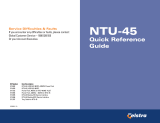
14
Table 3. Synchronous Data Port Options – Model 7975 (1 of 2)
Port Type
Possible Settings: E530A, V.35, RS449, X.21
Default Setting: E530A
Determines the port type for the data port.
NOTE: If X.21 is selected for Port Type, set Send All Ones on Data Port Not Ready
to RTS or Disable.
Payload Rate
Possible Settings: 64, 128, 192, 256, 320, 384, 448, 512, 576, 640, 704, 768, 832,
896, 960, 1024, 1088, 1152, 1216, 1280, 1344, 1408, 1472, 1536, 1600, 1664,
1728, 1792, 1856, 1920, 1984, 2048
Default Setting: [Highest multiple of 64 Kbps supported by the DSL Line Rate]
Specifies the payload rate of the port. This option is not displayed on the unit when
AutoRate is enabled or the unit is configured as an NTU. The LTU configures the
payload rate for the NTU. The highest multiple of 64 Kbps is used when Autorate is
enabled.
NOTE: Payload rates of 1088 Kbps and higher pertain only to 2 Mbps models.
Transmit Clock Source
Possible Settings: Internal, External
Default Setting: Internal
When configured as the LTU, specifies whether the transmitted data for the
synchronous data port is clocked using an internal clock provided by the LTU or an
external clock provided by the DTE connected to the synchronous data port.
Invert Transmit Clock
Possible Settings: Disable, Enable
Default Setting: Disable
When configured as the LTU and Transmit Clock Source is set to External, specifies
whether the clock supplied by the the unit on the TXC interchange circuit DB
(ITU-T 114) is phase inverted with respect to the Transmitted Data interchange circuit
BA (ITU-T 103). This configuration option is useful when an excessive cable length
between the unit and the DTE causes errors.




























